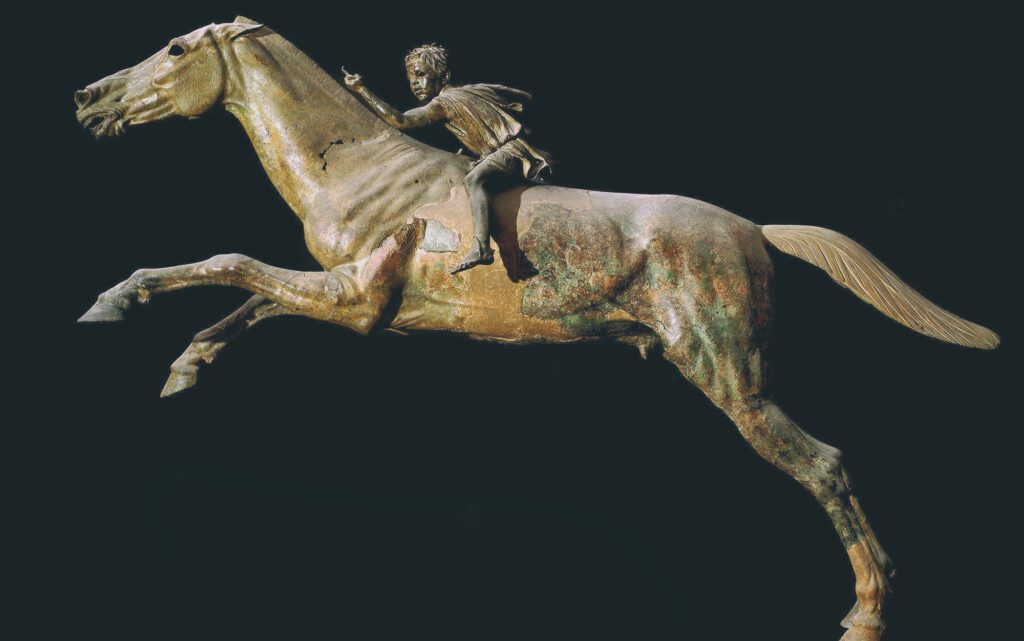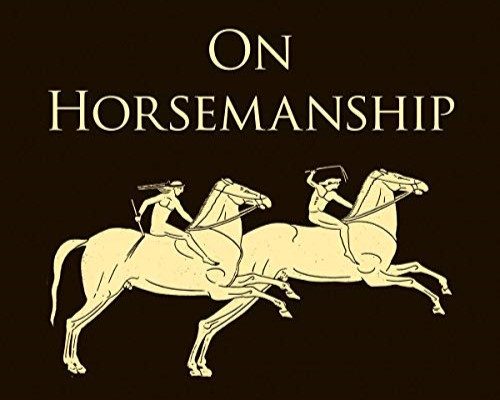Xenophon is known as the first author ever to have written a complete text about horses, their selection, care and training. One text is more ancient (by Kikkuli of the Mitanni Kingdom) but clearly not as complete as this one.
On Horsemanship (Περὶ ἱππικῆς, peri hippikēs) has been written by Xenophon around 350 B.C. and is known as the first book ever written on the subject of horses, their selection, care, and training. One text is more ancient (written by Kikkuli of the Mitanni Kingdom) but clearly not as complete as this one. It is quite interesting to observe that most of the major principles on which modern Natural Horsemanship is based were already well known more than two thousand years ago in Greece and around the Mediterranean Sea. Indeed, the philosopher Xenophon clearly deals with the following concepts:
Table of Contents
Desensitizing
“The groom should […] make [the colt] familiar with all sorts of sights and noises […], he must teach him _ not by cruel, but by gentle handling _ that they are not really formidable.”
(Chapter II)
Please note the fact that the author emphasizes the notion of gentleness.
Gentleness and patience
“The one best precept _ the golden rule _ in dealing with a horse is never to approach him angrily. Anger is so devoid of forethought that it will often drive a man to do things which in a calmer mood he will regret.”
(Chapter VI)
That is probably the most important lesson given by Xenophon, as it concerns our relations with horses of course, but also our relations with others.

Timing and harmony with horses
“It will best conduce to [the left foot] lead if, while the horse is still trotting, the signal should be given at the instant of making a step with his right foot. As he is on the point of lifting his left foot he will start upon it, and while turning left will simultaneously make the first bound of the gallop.”
(Chapter VII)
That is what Ray Hunt described in his book Think in Harmony with Horses and the essence of the answer Buck Brannaman gave me when I asked how to train a horse to take the good lead: feel his rhythm and ask when the time comes on the left side for a left lead and on the right side for the right lead.
Diversity in training
“It is a correct principle to vary exercises […] The horse will take much more kindly to them if you do not confine him to one place and one routine.”
(Chapter VIII)
Every horse owner and trainer should have this sentence in mind when taking their horses from a 9 m² box to the arena for a two-hour lunging session before forcing them back to the box.
Making the wrong thing difficult and the right thing easy
“If you would have a horse learn to perform his duty, […] whenever he does as you wish, […] show him some kindness in return, and when he is disobedient […] chastise him.”
(Chapter VIII)
Xenophon does not describe the type of kindness or how to chastise a horse, yet he emphasizes the fact that “this principle, […] is one which holds good throughout the whole of horsemanship.”
Getting the soft feel and avoiding riding gimmicks
“You must abstain from pulling at his mouth with the bit, or applying the spur and whip [which] achieve the very opposite of what [show people] are aiming at.”
“The horse’s mouth is not to be pulled back too harshly so as to make him toss his head aside […] But the instant he raises his neck in answer to the pull, give him the bit at once.”
(Chapter X)
Both quotations quite clearly illustrate Xenophon’s point of view about those gimmicks our stores are full of: martingales, draw reins, tie downs, etc. The Soft Feel as so called by Buck Brannaman is, as far as I know, the only gentle way to collect efficiently a horse.
Rewarding the slightest try
“Whenever [the horse] performs his service well, reward and humour him.”
(Chapter X)
“The best method of instruction […] is to let the horse feel that whatever he does in obedience to the rider’s wishes will be followed by some rest and relaxation.”
(Chapter XI)
General considerations by Xenophon
Moreover, we can also find some considerations about hoof care that would please all barefoot supporters: “A stable with a damp and smooth floor will spoil the best hoof which nature can give.“ Also about tack and the use of it: “Smooth bits are better and more serviceable than rough,” adding that if we have to use less friendly bits we should compensate “as much as possible by lightness of hand.”
Yet, we can of course find some contradictory occurrences as the philosopher advises to ask for the help of “some one with a whip [to] apply it smartly” or “to be ready to apply the spur“. I would like to relativise these words though as we have to keep in mind that Xenophon lived a few centuries before our era, and that book is addressed to soldiers training their horses for battles.
“To quote a dictum of Simon, what a horse does under compulsion he does blindly, and his performance is no more beautiful than would be that of a ballet-dancer taught by whip and goad.”
On Horsemanship, Xenophon

As a conclusion, I would like to insist on the fact that all basics about a gentle and respectful approach of the horse were already known and supported by important people two millennia ago. So, keep that in mind when you meet some of those guys who tell you they have found, discovered or invented a new method, new horsemanship principles… either they lie, or they do not know what they are talking about: I do not know which one is the worst when dealing with horses.
Tip: On Horsemanship can be found for free on the internet.
www.gutenberg.org
